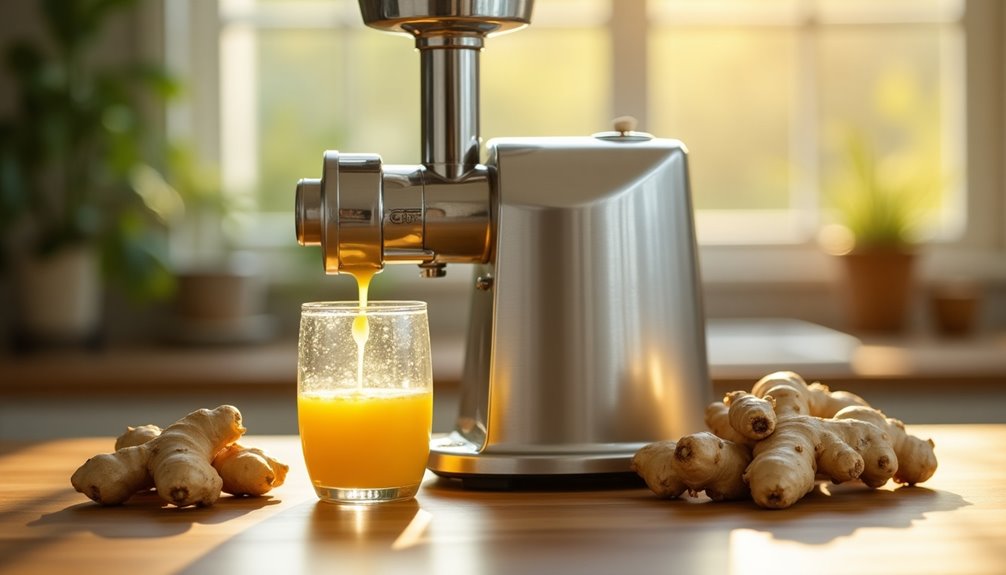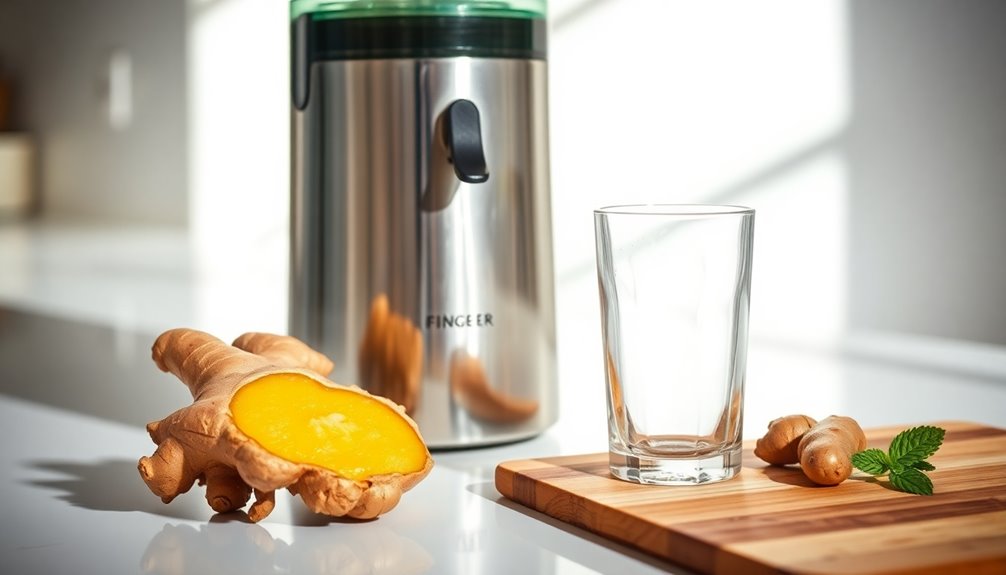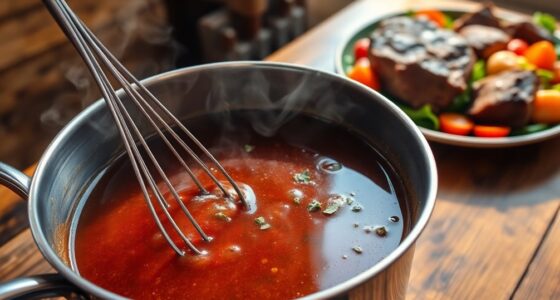To juice ginger with a juicer, start by scrubbing organic ginger root under running water. There's no need to peel it. Cut it into 1-2 inch pieces, ensuring they fit in the juicer's chute. Set up your juicer with a container to catch the juice and feed in the ginger gradually. You'll get a more concentrated juice without the extra filtering needed with a blender. Want to discover more tips and ways to use ginger juice?
Key Takeaways
- Choose organic ginger root, scrub it clean, and cut into 1-2 inch pieces for easy juicing.
- Set up the juicer with a container beneath to collect the freshly extracted ginger juice.
- Gradually feed the ginger pieces into the juicer for efficient extraction without the need for filtering.
- Save the leftover ginger pulp to enhance soups and teas, maximizing the use of the organic ginger.
- Store ginger juice in an airtight glass bottle in the refrigerator for 2-3 days or freeze in ice cube trays for longer use.

Juicing ginger is a simple and rewarding process that can elevate your culinary creations and boost your health. Whether you're looking to add a zesty kick to your dishes or harness the numerous health benefits of ginger, using a juicer makes the process quick and easy. You'll love how fresh ginger juice can enhance the flavors in your recipes, plus it's a great way to incorporate this powerful root into your diet.
To start, you'll need some organic ginger root. It's important to choose fresh ginger rather than dried or powdered varieties, as the flavor and health benefits are much more potent in the fresh form. First, scrub the fresh ginger root under running water to remove any dirt. You don't need to peel it if you're using organic ginger, as the skin is perfectly fine to juice.
Once it's clean, cut the ginger into 1-2 inch pieces. This makes it easier for the ginger to fit into your juicer's chute. Next, set up your juicer by placing a container underneath its spout to catch the freshly extracted ginger juice. Start feeding the ginger pieces into the juicer. You might find that a juicer extracts juice more efficiently than a high-speed blender, which often requires additional filtering.
Once you've juiced all your ginger, you'll be left with leftover pulp. Don't toss that pulp just yet! You can save it for use in other recipes, such as soups or teas, to get the most out of your organic ginger.
After juicing, you'll want to store your ginger juice properly. Pour it into an airtight glass bottle to keep it fresh. Storing it in the refrigerator allows it to last for 2-3 days, but if you want to preserve it longer, consider freezing it in ice cube trays. This way, you can pop out a cube whenever you want to add a burst of ginger flavor to your drinks, smoothies, or cooking.
Now, let's talk about the health benefits of ginger. The juice contains compounds that can help with digestion, inflammation, and even nausea. Adding ginger juice to your daily routine can support your overall health and wellness. You can mix it with filtered water for a refreshing drink, or incorporate it into salad dressings, marinades, and smoothies for an extra zing.
Frequently Asked Questions
Do You Peel Ginger Before Putting in a Juicer?
You don't always have to peel ginger before juicing it. If you've got organic ginger, just scrub it clean to remove any dirt.
For non-organic ginger, it's best to peel it to get rid of pesticides. You can easily peel it with the back of a spoon to save time and reduce waste.
What Type of Juicer Is Best for Ginger?
When you're choosing a juicer for ginger, consider a centrifugal juicer for its speed and efficiency.
However, if you want to maximize juice yield and retain nutrients, a masticating juicer's the way to go.
Look for models with a wide feed chute to minimize prep time and a robust motor, ideally 600 watts or more, to handle ginger's toughness.
Easy-to-clean designs can also save you time after juicing.
Is Juicing Ginger Good for You?
Isn't it amazing how one ingredient can pack so many benefits? Juicing ginger is definitely good for you!
It's loaded with gingerol, which fights inflammation and boosts your antioxidant levels. If you're dealing with nausea, ginger juice can offer relief, making it a go-to remedy.
Plus, it supports digestion and helps regulate blood sugar. With its low calorie count, incorporating ginger juice into your diet can enhance your overall health.
What Is the White Stuff When You Juice Ginger?
When you juice ginger, the white stuff you see is fibrous pulp.
It's made up of ginger's fibrous tissues, which don't break down completely during juicing. This pulp contains essential nutrients and can add a spicy kick to your dishes.
Depending on your juicer, the amount of pulp can differ; masticating juicers usually leave less.
You can reuse this pulp in smoothies, teas, or even baked goods for extra flavor.
Conclusion
Juicing ginger is a breeze, and once you've tried it, you'll wonder how you ever lived without its zesty flavor and health benefits! Just remember to prep your ginger properly and let your juicer work its magic. In no time, you'll have a potent elixir that'll kick your smoothies and recipes up to a whole new level of deliciousness. So grab that juicer, and unleash the power of ginger—it's like adding a rocket booster to your wellness journey!
Cindy thoroughly researches juicing trends, techniques, and recipes to provide readers with practical advice and inspiration. Her writing style is accessible, engaging, and designed to make complex concepts easy to understand. Cindy’s dedication to promoting the advantages of juicing shines through her work, empowering readers to make positive changes in their lives through the simple act of juicing.











